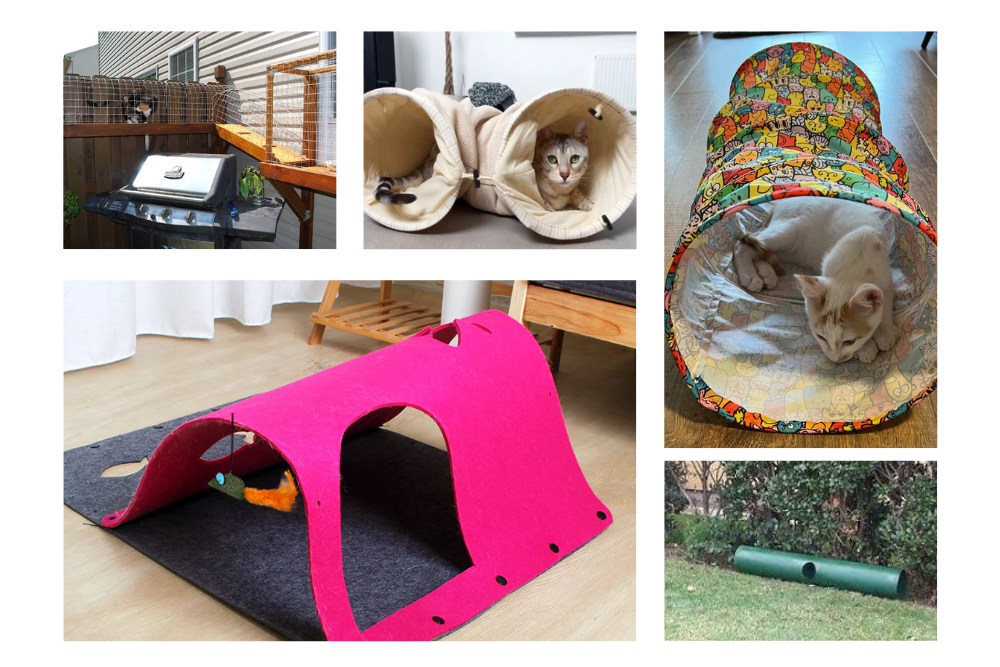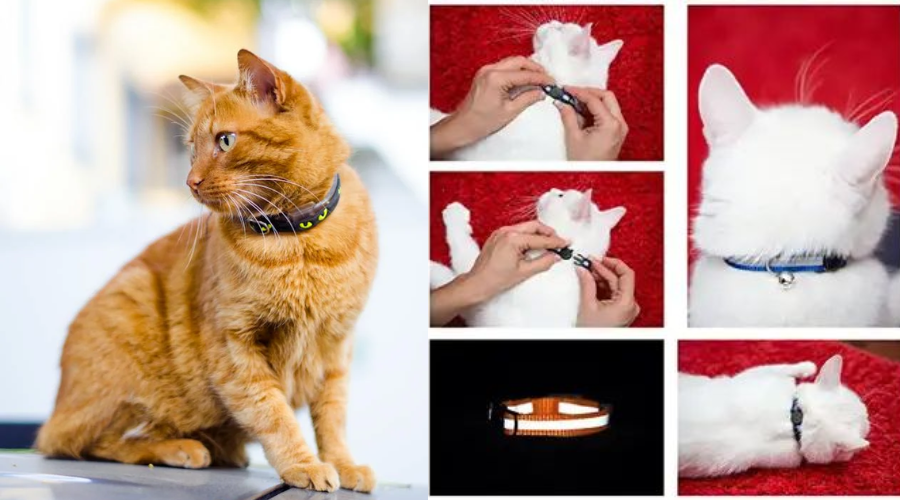Cats absolutely adore playing and snoozing in tunnel beds, and it’s not just a random choice—they’ve got some pretty cute reasons for it! Think of it like a kitty vacation home. You see, in the wild, our furry friends like having cozy spots to hide and feel safe. Cat tunnel bed give them that snug feeling they love so much, making them feel secure and content. Plus, the tunnel shape turns it into a kitty playground, perfect for all those playful antics. Picture your cat doing some expert stalking, playful pouncing, and maybe even a bit of stealthy hiding. It’s like a feline paradise! And let’s not forget the comfy factor. The soft, padded interior is like a fluffy cloud, turning the tunnel bed into the ultimate nap spot. So, when your cat curls up in their tunnel bed, it’s not just about the coziness—it’s a full-on satisfaction of their natural instincts and a touch of playful joy!
The 10 DIY Cat Tunnels
Kid-sized Pajama and Wire Tunnel
For the kid-sized pajama and wire tunnel, begin by selecting two pairs of kid-sized pajamas. Thread wire through the waist strap of the pajamas, and strategically sew four straws at opposing points of the waist strap. Once completed, bring the two pairs of shorts together. The end result is a perfectly sized tunnel that your cats can comfortably squeeze into, providing them with a cozy hideaway to explore.
Old Sweater and Foam Tunnel
To create the old sweater and foam tunnel, start by cutting the arms and bottom of an old sweater. Attach foam padding to the cut edges for added structure. Sew or glue the sweater into a tunnel shape, ensuring the foam provides a soft and comfortable interior. The result is a cozy tunnel made from repurposed materials, offering your cat a warm and inviting space for play and relaxation.
Cardboard Cat Tunnel
For the cardboard cat tunnel, gather various-sized cardboard boxes, duct tape, and craft paper or wrapping paper. Connect the boxes using duct tape to form a tunnel shape, and cover the outside with craft paper for aesthetic appeal. Customize the tunnel with additional openings for entry and exit points. This affordable and customizable DIY option provides your cat with an engaging and entertaining space.
PVC Pipe Maze
To craft the PVC pipe maze, acquire PVC pipes of different lengths and diameters, along with connectors and a PVC pipe cutter. Cut the PVC pipes into various lengths and connect them using PVC connectors to create a maze-like structure. Ensure the maze is stable and secure, and customize it with additional openings or turns. This DIY project results in a durable and engaging PVC pipe tunnel maze for your cat to explore.
Fabric and Hula Hoop Tunnel
Create the fabric and hula hoop tunnel by attaching fabric to a hula hoop using Velcro or a zipper. Shape the fabric around the hula hoop to form a tunnel, ensuring it is securely attached for stability. Place the hula hoop horizontally or vertically based on your cat’s preference. This flexible and easily adjustable fabric tunnel provides a comfortable and entertaining space for your feline friend.
Cat-friendly Labyrinth
Assemble the cat-friendly labyrinth using wooden boards, nails or screws, and soft padding or carpet. Arrange the wooden boards into a labyrinth structure, securing them with nails or screws. Add soft padding or carpet to the interior surfaces, and create various entry and exit points within the labyrinth. The result is a multi-level labyrinth that satisfies your cat’s curiosity and offers a unique environment for exploration.
Spiral Rope Tunnel
Craft the spiral rope tunnel by coiling thick rope into a spiral shape and gluing it together to maintain the spiral structure. Attach wooden or plastic rings at intervals for added interest. Ensure the spiral is stable and won’t unravel during use. This visually appealing and tactile spiral rope tunnel provides an engaging and stimulating space for your cat to play and relax.
Sisal-wrapped Tunnel
For the sisal-wrapped tunnel, wrap sisal rope around a cardboard or PVC pipe. Use glue to secure the sisal in place at regular intervals, ensuring a tight and secure wrapping for durability. Create openings for entry and exit points to allow your cat easy access. The result is a sturdy and satisfyingly scratchable sisal tunnel that enhances your cat’s playtime.
Felt-covered Tunnel with Windows
Cover PVC pipes with felt fabric to create the felt-covered tunnel with windows. Use glue or adhesive to secure the felt in place, and carefully cut out windows along the length of the tunnel. Ensure the windows are evenly spaced for visibility and create a cozy interior with additional felt layers. The result is a visually interesting and peek-a-boo tunnel that offers your cat an engaging and playful space.
Hanging Tunnel with Fleece
Construct the hanging tunnel with fleece using wire or a PVC frame, fleece fabric, and hooks for hanging. Create a frame using wire or PVC for hanging and attach fleece fabric to form a suspended tunnel. Ensure the frame is secure and won’t collapse during use. Hang the tunnel at a height suitable for your cat to enjoy a unique and exciting hanging tunnel experience.
Outdoor Cat Tunnel
Creating outdoor tunnels for your cat is a delightful project that enhances their outdoor experience. To get started, carefully plan the layout of the tunnels, taking into consideration your cat’s favorite spots and any existing structures in your yard. Aim for a combination of straight paths, curves, and hiding spots to provide a diverse and engaging environment.
Next, measure and cut the tunnels to your desired dimensions. If you’re using PVC pipes, connect them with connectors to form the tunnel shapes. Alternatively, if you prefer chicken wire, shape it into tunnels and secure the edges using zip ties or strong wire. Pay attention to the length and width to ensure your cat can comfortably navigate through the tunnels.
Once you have assembled the tunnels, it’s crucial to secure them to the ground. Use wooden stakes or other supports to anchor the tunnels firmly, ensuring stability and preventing any unintended collapses. If you’ve chosen PVC pipes, consider painting them with outdoor-friendly paint to enhance their durability and weather resistance.
To create a secure and enclosed space, cover the tunnels with landscape fabric or mesh. This step is essential to prevent escapes and to maintain a safe environment for your cat. Ensure that the covering is securely attached to the tunnels, providing a reliable barrier.
For an extra touch, you can add outdoor carpet or artificial grass inside the tunnels. This not only adds comfort for your cat but also enhances the overall aesthetic of the outdoor space. Make sure any materials you use are cat-friendly and safe for outdoor use.
Building outdoor tunnels for your cat offers a unique and enriching experience, allowing them to explore the outdoors in a controlled and secure environment. Monitor your cat’s interactions with the tunnels, and consider adding additional elements like toys or scratching posts to further enhance their outdoor playtime.
These DIY cat tunnels provide diverse options for cat owners to engage their feline friends in stimulating and comfortable environments. Choose the design that best suits your cat’s preferences and enjoy crafting these fun projects!
How to Encourage your Cat to use Cat Cave or Tunnel
Encouraging your cat to use a cat cave or tunnel involves creating a positive and enticing environment. Here’s a detailed guide in paragraph form on how to ensure your cat embraces their cozy hideaway:
The first step in encouraging your cat to use a cat cave or tunnel is to consider its placement. Choose a quiet and comfortable location where your cat already feels secure. Avoid placing it in high-traffic areas, as cats prefer spaces where they can have some privacy. By selecting the right location, you provide a sense of security that encourages your cat to explore the new space.
Introduce your cat to the cat cave by placing familiar scents inside. Use some of their favorite toys, blankets, or bedding to make the interior inviting. Cats rely heavily on scent, and by associating their familiar smells with the new space, you make it more appealing and reassuring.
Allow your cat to explore the cat cave at their own pace. Avoid forcing them inside or making sudden movements that might startle them. Cats are naturally curious, so let their curiosity lead the way. If they approach the cave on their own, it’s a positive sign that they are ready to investigate.
Encourage your cat to enter the cat cave by using treats and positive reinforcement. Start by placing treats near the entrance and gradually move them further inside. Reward your cat with treats for each step they take inside the cave. Positive associations with treats make the cat cave a source of positive experiences, increasing the likelihood that your cat will return to explore further.
Engage in interactive play around the cat cave to create positive associations. Use your cat’s favorite toys to lure them in and out of the tunnel. Make it a fun and enjoyable experience by incorporating playtime near and around the cat cave. Cats are more likely to explore spaces that are associated with positive and enjoyable activities.
Ensure the interior of the cat cave is comfortable and inviting. Place a soft blanket or cushion inside to make it a cozy retreat. Cats appreciate comfortable and soft surfaces, and providing a pleasant interior enhances the appeal of the cat cave as a relaxing and secure space.
Be patient and observe your cat’s behavior. Some cats may take time to warm up to new spaces. Allow them the freedom to explore the cat cave at their own pace, without pressuring them. Patience is key, and by giving your cat time to adapt, they are more likely to feel comfortable and confident inside the new space.
Keep the space interesting by rotating toys and occasionally adding catnip. Cats are attracted to new and stimulating elements. By introducing variety into the cat cave, you capture your cat’s curiosity, making it an ever-changing and exciting place to explore.
Cats are naturally inclined to seek out enclosed spaces for safety and security. Mimic natural hiding spots by placing the cat cave near a wall or in a corner. This provides a sense of security and mimics the types of spaces cats naturally seek out in the wild.
Be consistent in your approach. Once your cat starts using the cat cave, maintain a routine to reinforce the positive behavior. Consistency provides reassurance and helps your cat feel secure in their newfound hideaway.
Encouraging your cat to use a cat cave or tunnel involves thoughtful placement, gradual introduction, positive reinforcement, and creating a comfortable and inviting space. By understanding your cat’s preferences and providing a positive association with the new environment, you’ll likely find your feline friend willingly embracing their new hideaway for rest and relaxation.
Benefits of DIY Cat Tunnels
Discover the advantages of opting for a DIY approach to cat tunnel beds. Not only do these projects offer cost-effective solutions, but they also allow for personalized designs that cater to your cat’s unique preferences. Strengthen your bond with your feline companion through the shared experience of crafting their favorite hideaway.
The benefits of DIY cat tunnels extend beyond the joy of crafting. Here’s a detailed exploration of the advantages your feline friend can enjoy:
Creating a DIY cat tunnel is often more budget-friendly than purchasing ready-made alternatives. By using materials you already have or can acquire inexpensively, you provide your cat with an enriching environment without breaking the bank.
DIY cat tunnels allow for customization based on your cat’s preferences. You can choose colors, textures, and sizes that align with your cat’s unique tastes. This personal touch enhances the likelihood that your cat will embrace and enjoy the tunnel you’ve crafted.
Engaging in DIY projects for your cat can be a bonding experience. As you spend time crafting the tunnel, your cat may show interest and curiosity, strengthening the connection between you and your feline companion.
DIY cat tunnels contribute to mental stimulation. The variety of materials, textures, and shapes can engage your cat’s curiosity and intellect, providing an outlet for mental energy and preventing boredom.
Encouraging play and exploration, DIY cat tunnels promote physical exercise. Cats are natural hunters and explorers, and a well-designed tunnel can facilitate running, pouncing, and climbing – all essential activities for maintaining a healthy weight and overall well-being.
Tunnels, whether purchased or homemade, mimic the secure and enclosed spaces that cats naturally seek. DIY tunnels offer the added benefit of being customizable to your cat’s preferred level of privacy, providing them with a safe retreat when they need a break.
Cat Tunnel Beds in the Commercial Market
Explore popular commercial options for cat tunnel beds, including renowned brands and models. Understand the key features to look for when purchasing ready-made tunnels, and benefit from reviews and recommendations from fellow cat owners.
Conclusion
In conclusion, cat tunnel beds offer a myriad of benefits for your furry companions. Whether you choose a commercial option or embark on a DIY project, the positive impact on your cat’s well-being is undeniable. Encourage fellow cat owners to explore the world of tunnel beds, creating a haven that combines comfort, playfulness, and security for their beloved feline friends.
FAQs about Cat Tunnel Beds
Do cats like tunnel beds? Understanding feline behavior is key to comprehending their affinity for tunnel beds. Cats, known for their love of hiding and stalking, find tunnel beds irresistible. The enclosed space appeals to their instinctual need for security and provides an ideal environment for play and relaxation. Discover the numerous benefits of introducing a tunnel bed into your cat’s life.
Are cat tunnels good for cats? Cat tunnels offer more than just a cozy spot for a nap. They contribute significantly to a cat’s overall well-being by providing mental stimulation, encouraging physical exercise, and creating a sense of security. Learn how incorporating a tunnel bed into your cat’s environment can enhance their quality of life.
Why do cats like sleeping in tunnels? Delve into the reasons behind cats’ preference for sleeping in tunnels. Uncover the instinctual behaviors that drive this choice and explore how tunnel beds mimic the natural environments that cats find comforting. Understand why these spaces become havens for restful feline slumber.
Q: Are tunnel beds suitable for all cat breeds? A: Yes, tunnel beds cater to various breeds, but it’s essential to consider your cat’s individual preferences and size.


